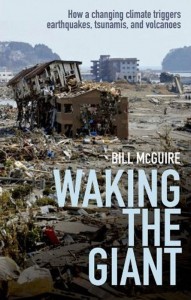 How can climate change affect the Earth?
How can climate change affect the Earth?
Last Saturday I heard Bill Mcguire, Professor of Geophysical & Climate Hazards at University College London, talk about how a changing climate can trigger earthquakes, tsunamis, and volcanoes. Ironically he was speaking at Cromford Mill in Derbyshire, which contributed, as much as anywhere else, to the start of the Industrial Revolution . It was here that Richard Arkwright proudly opened the world’s first factory nearly 250 years ago.
Spotlight on Bill McGuire
- 2005; Member of the UK Government’s Natural Hazards Working Group (established in 2005 in the wake of the 2004 Indian Ocean tsunami)
- 2010; Member of the Scientific Advisory Group for Emergencies (SAGE), addressing the Icelandic ash problem.
- Contributing author for the 2011 IPCC Report on climate change and extreme events.
Waking the giant
As a result of hearing him I bought his book, called Waking the Giant. He explains simply how climate change does in fact affect the solid Earth and its natural hazards. In the process of unpacking his argument Bill looks at the history of the earth and its changes. He puts together an unequivocally convincing and scary argument for the rapid rate of climate change. It is perhaps the scariest thing I have read about climate change to date. As a geologist he studies the changes occurring over millions of years so his view point is somewhat different to the usual arguments we hear for climate change. The arguments are, indeed earth shattering. However the thing that has driven me to write up these notes is his assessment and review of where we are with climate change.
What’s covered in the book
In his book, Bill Mcguire is absolutely clear we are in the midst of the most dramatic changes, His opening chapter summarises the twists and turns by the IPCC. He also reminds us about the underplaying of facts (the potential break-up of the polar ice sheets, methane release from permafrost thawing) by the IPCC Fourth Assessment report 2007. Whilst the IPCC claims this omission is due to a lack of scientific knowledge, a sceptic may conclude that there is little chance of an assessment ever being performed that would explicitly investigate the potential ramifications of ice sheet collapse, methane exhalation across the Siberian tundra, and the failure of the oceans to continue to act as a sponge for our carbon pollution and excess heat production. He then discusses the subsequent synthesis report (written before the Copenhagen talks in 2009). This report flags up the longevity of anthropogenic climate change, reminding us that the consequences of our activities today will still be felt 50 generations and further down the line. Because of the enormous inertia in the climate system, even when (and if) anthropogenic greenhouse gas emissions are reduced to nothing, global temperatures will barely fall at all for at least a thousand years.
The difficulties of making predictions
As physicist Niels Bohr first and most famously observed, and many others have since reiterated, ‘predicting is very difficult; especially for the future’. Even with the best will in the world modelling something as complex and interactive as the Earth’s climate may never be able to provide us with an accurate picture of what our planet will look like 100 years from now and beyond.
Maybe then, the best way to gauge the nature of the world to come is to look back rather than to project forward. Zeroing in on the post-glacial period, for example, reveals the many and varied ways in which a dramatically changing climate evoked a dynamic response from the crust beneath our feet, and might do so again. Alternatively, studying previous occasions when carbon-dioxide-enriched atmospheres were the order of the day, may better inform us about the consequences of increased greenhouse gas concentrations than any number of computer projections.
Bill McGuire concludes…
The book concludes that a common failing of human beings, both as individuals and collectively, is their apparent inability to imagine a world or a life any different from the one they are experiencing at any given time. Arguably, this is the greatest obstacle faced by climate scientists trying to make national governments, institutions, businesses, and people generally wake up and pay attention to the massive threat they face–to appreciate what an appalling impact unmitigated anthropogenic climate change could have on our world and our descendants.
For more information about how climate change can affect the Earth’s crust feel free to watch this video .
